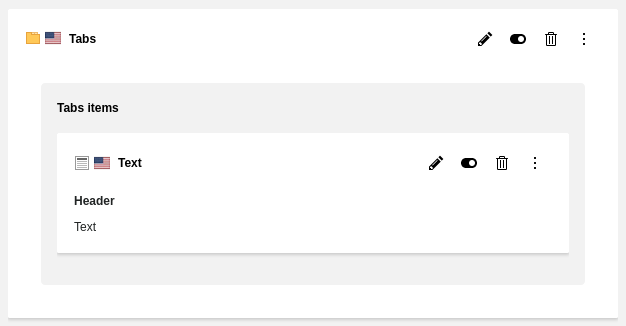Nested Content Elements
It is possible to nest Content Elements within Content Blocks. By default, TYPO3 would render those nested elements within the TYPO3 Page Module in the backend and the frontend output. Content Blocks delivers an API and integration for common setups to prevent this unwanted behaviour.
Note
This will not replace proper grid extensions like EXT:container, as this solution does not provide drag and drop or creation of new child elements in the Page Module.
How to create nested Content Elements
In order to have nested Content Elements, we need to make use of the field type
Collection. This field type allows us to have a
relation to another table. In our case
tt_.
name: example/tabs
fields:
- identifier: header
useExistingField: true
- identifier: tabs_item
type: Collection
minitems: 1
foreign_table: tt_content
allowedRecordTypes:
- example_textThis config creates a field, where you can create new Content Elements within your root Content Element. With the option allowedRecordTypes it is possible to restrict certain Content Types.
Render nested Content Elements in the frontend
There are two ways to render nested Content Elements. The first one is to reuse
the basic rendering definition of the child element. This is already
pre-rendered in the Fluid variable {data._. This variable
contains all relations which might have a frontend rendering definition defined
in TypoScript. Normally, these are only Content Elements.
<f:for each="{data._grids.tabs_item}" as="item" iteration="i">
<f:comment><!-- {item.data} contains the Content Block data object. --></f:comment>
<div class="tab-item" data-uid="{item.data.uid}">
<f:comment><!-- {item.content} contains the rendered html. --></f:comment>
<f:format.raw>{item.content}</f:format.raw>
</div>
</f:for>Note
This is the same as triggering the rendering with
f: view
helper:
<f:cObject typoscriptObjectPath="tt_content.example_text" table="tt_content" data="{data}"/>The second method is to define an alternative rendering within your Fluid template. This means you can have a default rendering definition for your Content Element, when used as a root Content Element and an alternative one if used as a child. This method is a lot more flexible, but requires a little bit more work.
<f:for each="{data.tabs_item}" as="item" iteration="i">
<div class="tab-item" data-uid="{item.uid}">
<h2>{item.header}</h2>
<f:format.html>{data.bodytext}</f:format.html>
</div>
</f:for>Tip
You can also use global partials for the second method to have less duplication.
Render nested Content Elements in the backend
Similarly to frontend rendering, it's also possible to render nested content in the backend. For this Content Blocks provides ready to use Fluid partials which are able to render backend previews the same way the Core page layout does it.
<f:render partial="PageLayout/Grid" arguments="{data: data, identifier: 'tabs_item'}"/>The partial is called PageLayout/Grid and accepts your current Content Block data object as well as the identifier of the Collection field, which you want to render.

The partial renders the grid layout from the Core.
This preview is limited to control buttons like edit, delete and hide. No support for drag and drop or creation of new child elements is given.
When to use nested Content Elements vs. container extensions
Many problems can be solved with either solution. However, as a rule of thumb, as soon as you need dynamic multi-grid components for your page, you are better off using something like EXT:container. For example "Two-Column container", "1-1-2 Container" or "Wrapper Container".
On the other hand, if you create a self-contained element, which should hold child Content Element relations and these child elements are unlikely to be moved elsewhere, you might be better off using simple nested Content Elements. An example could be a "Tab module" or a "Content Carousel".
Concept
The nesting is done via one database field
holding a reference to the parent Content Element. The
col column will
always be 0, which is also the reason why it would otherwise be rendered by
TYPO3 even though created within another Content Element.
Extensions like EXT:container work completely different as they assign a specific colPos value to the child elements.
Preventing output in frontend
Output in frontend is prevented by extending
styles.
condition. This is done via
post, which will extract all
defined parent reference columns. Those are added to the SQL statement in order
to prevent fetching any child elements.
Note
If you do not build upon
styles. or the
Page,
you need to integrate the logic yourself. The necessary API providing all
the columns is available via
TYPO3\.
This can be used to apply the same approach to
Database.
Example:
20 = CONTENT
20 {
table = tt_content
select {
where = {#colPos}={register:colPos}
where.insertData = 1
where.postUserFunc = TYPO3\CMS\ContentBlocks\UserFunction\ContentWhere->extend
}Preventing output in backend
TYPO3 provides an event to alter the SQL query to fetch content for the Page Module in the backend. Content Blocks adds an event listener to apply the same logic as for the frontend.
